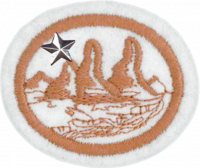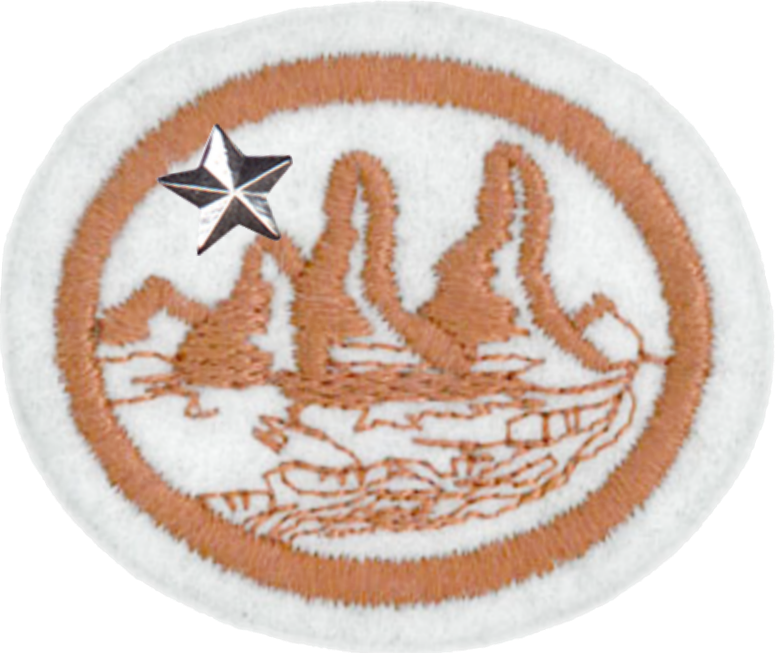Difference between revisions of "AY Honors/Geology - Advanced/Answer Key/es"
From Pathfinder Wiki
< AY Honors | Geology - AdvancedAY Honors/Geology - Advanced/Answer Key/es
(Created page with "</noinclude> {{clear}} <noinclude>") |
(Updating to match new version of source page) |
||
| (17 intermediate revisions by 2 users not shown) | |||
| Line 1: | Line 1: | ||
| − | + | {{HonorSubpage}} | |
| − | + | <!--{{Honor_Master|honor=Geology - Advanced|master=Conservation}}--> | |
| − | {{ | ||
| − | |||
| − | |||
| − | |||
| − | |||
| − | |||
| − | |||
| − | |||
| − | }} | ||
| − | |||
| − | {{Honor_Master | ||
| − | |||
| − | |||
<section begin="Body" /> | <section begin="Body" /> | ||
{{ansreq|page={{#titleparts:{{PAGENAME}}|2|1}}|num=1}} | {{ansreq|page={{#titleparts:{{PAGENAME}}|2|1}}|num=1}} | ||
<noinclude></noinclude> | <noinclude></noinclude> | ||
| − | <!-- 1. | + | <!-- 1. Tener la especialidad de Geología. --> |
| − | {{honor_prerequisite| | + | {{honor_prerequisite|honor=Geology|displayname=Geología}} |
<noinclude></noinclude> | <noinclude></noinclude> | ||
| Line 24: | Line 11: | ||
{{ansreq|page={{#titleparts:{{PAGENAME}}|2|1}}|num=2}} | {{ansreq|page={{#titleparts:{{PAGENAME}}|2|1}}|num=2}} | ||
<noinclude></noinclude> | <noinclude></noinclude> | ||
| − | <!-- 2. | + | <!-- 2. Proporcionar la siguiente información: --> |
<noinclude></noinclude> | <noinclude></noinclude> | ||
{{ansreq|page={{#titleparts:{{PAGENAME}}|2|1}}|num=2a}} | {{ansreq|page={{#titleparts:{{PAGENAME}}|2|1}}|num=2a}} | ||
| Line 46: | Line 33: | ||
<noinclude></noinclude> | <noinclude></noinclude> | ||
| − | {{clear}} | + | {{clear}} |
{{clear}} | {{clear}} | ||
| Line 60: | Line 47: | ||
{{ansreq|page={{#titleparts:{{PAGENAME}}|2|1}}|num=3}} | {{ansreq|page={{#titleparts:{{PAGENAME}}|2|1}}|num=3}} | ||
<noinclude></noinclude> | <noinclude></noinclude> | ||
| − | <!-- 3. | + | <!-- 3. ¿En qué lugar en el mundo se puede ver: --> |
<noinclude></noinclude> | <noinclude></noinclude> | ||
{{ansreq|page={{#titleparts:{{PAGENAME}}|2|1}}|num=3a}} | {{ansreq|page={{#titleparts:{{PAGENAME}}|2|1}}|num=3a}} | ||
| Line 85: | Line 72: | ||
{{ansreq|page={{#titleparts:{{PAGENAME}}|2|1}}|num=3e}} | {{ansreq|page={{#titleparts:{{PAGENAME}}|2|1}}|num=3e}} | ||
<noinclude></noinclude> | <noinclude></noinclude> | ||
| − | |||
| − | |||
{{clear}} | {{clear}} | ||
| Line 93: | Line 78: | ||
{{ansreq|page={{#titleparts:{{PAGENAME}}|2|1}}|num=3f}} <!--T:12--> | {{ansreq|page={{#titleparts:{{PAGENAME}}|2|1}}|num=3f}} <!--T:12--> | ||
<noinclude></noinclude> | <noinclude></noinclude> | ||
| − | |||
<noinclude></noinclude> | <noinclude></noinclude> | ||
| Line 99: | Line 83: | ||
{{ansreq|page={{#titleparts:{{PAGENAME}}|2|1}}|num=3g}} <!--T:13--> | {{ansreq|page={{#titleparts:{{PAGENAME}}|2|1}}|num=3g}} <!--T:13--> | ||
<noinclude></noinclude> | <noinclude></noinclude> | ||
| − | |||
<noinclude></noinclude> | <noinclude></noinclude> | ||
| Line 105: | Line 88: | ||
{{ansreq|page={{#titleparts:{{PAGENAME}}|2|1}}|num=3h}} <!--T:14--> | {{ansreq|page={{#titleparts:{{PAGENAME}}|2|1}}|num=3h}} <!--T:14--> | ||
<noinclude></noinclude> | <noinclude></noinclude> | ||
| − | |||
| − | |||
{{clear}} | {{clear}} | ||
<noinclude></noinclude> | <noinclude></noinclude> | ||
| Line 112: | Line 93: | ||
{{ansreq|page={{#titleparts:{{PAGENAME}}|2|1}}|num=3i}} | {{ansreq|page={{#titleparts:{{PAGENAME}}|2|1}}|num=3i}} | ||
<noinclude></noinclude> | <noinclude></noinclude> | ||
| − | |||
| − | |||
{{clear}} | {{clear}} | ||
<noinclude></noinclude> | <noinclude></noinclude> | ||
| Line 119: | Line 98: | ||
{{ansreq|page={{#titleparts:{{PAGENAME}}|2|1}}|num=3j}} | {{ansreq|page={{#titleparts:{{PAGENAME}}|2|1}}|num=3j}} | ||
<noinclude></noinclude> | <noinclude></noinclude> | ||
| − | |||
| − | |||
{{clear}} | {{clear}} | ||
| Line 128: | Line 105: | ||
{{ansreq|page={{#titleparts:{{PAGENAME}}|2|1}}|num=4}} | {{ansreq|page={{#titleparts:{{PAGENAME}}|2|1}}|num=4}} | ||
<noinclude></noinclude> | <noinclude></noinclude> | ||
| − | <!-- 4. | + | <!-- 4. Escribir un ensayo de 500 palabras sobre uno de los siguientes puntos: --> |
<noinclude></noinclude> | <noinclude></noinclude> | ||
{{ansreq|page={{#titleparts:{{PAGENAME}}|2|1}}|num=4a}} | {{ansreq|page={{#titleparts:{{PAGENAME}}|2|1}}|num=4a}} | ||
<noinclude></noinclude> | <noinclude></noinclude> | ||
| − | |||
| − | + | {{clear}} | |
| − | + | {{clear}} | |
| − | |||
| − | |||
| − | |||
| − | |||
<noinclude></noinclude> | <noinclude></noinclude> | ||
| Line 146: | Line 118: | ||
{{ansreq|page={{#titleparts:{{PAGENAME}}|2|1}}|num=4b}} <!--T:18--> | {{ansreq|page={{#titleparts:{{PAGENAME}}|2|1}}|num=4b}} <!--T:18--> | ||
<noinclude></noinclude> | <noinclude></noinclude> | ||
| − | |||
| − | + | {{clear}} | |
<noinclude></noinclude> | <noinclude></noinclude> | ||
| Line 154: | Line 125: | ||
{{CloseReq}} <!-- 4 --> | {{CloseReq}} <!-- 4 --> | ||
<noinclude></noinclude> | <noinclude></noinclude> | ||
| − | == | + | ==Referencias== |
| − | |||
<noinclude></noinclude> | <noinclude></noinclude> | ||
| − | + | {{CloseHonorPage}} | |
Latest revision as of 22:32, 14 July 2022
Geología - Avanzado
Nivel de destreza
2
Año
1975
Version
04.05.2024
Autoridad de aprobación
Asociación General
1
Tener la especialidad de Geología.
Para consejos e instrucciones, véase Geología.
2
Proporcionar la siguiente información:
2a
¿Cómo los terremotos nos dicen como es el interior de la tierra?
2b
¿Cómo puede una gran cantidad de agua (como en el diluvio de Noé) hacer en unos meses lo que un poco de agua le costaría miles o millones de años para hacer?
2c
¿Por qué hay evidencias de glaciares en los climas templados, donde ahora no hay glaciares?
2d
¿Cómo los creacionistas, que creen en un diluvio mundial y en una edad temprana para la tierra desde su creación, comprenden y utilizan el tiempo gráfico geológico?
2e
¿Cuál es la teoría de la deriva continental (placas tectónicas) y cómo pueden los creacionistas encajar tal actividad geológica en el tiempo, desde la creación?
3
¿En qué lugar en el mundo se puede ver:
3a
los grandes glaciares?
3b
volcanes activos?
3c
las dunas de arena?
3d
hundimientos de tierra?
3e
fiordos?
3f
montañas en bloques de fallas?
3g
montañas plegadas?
3h
acantilados calcáreos?
3i
témpanos de hielo?
3j
atolones?
4
Escribir un ensayo de 500 palabras sobre uno de los siguientes puntos:
4a
Describir los puntos interesantes sobre geología que usted pudo ver en un viaje que tuvo recientemente.
4b
Describir la actividad geológica que ocurrió a causa de una fuerte lluvia, inundación, huracán o que haya experimentado.


